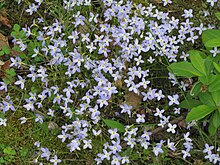Houstonia caerulea
| Houstonia caerulea | |
|---|---|

| |
| Scientific classification | |
| Kingdom: | |
| (unranked): | |
| (unranked): | |
| (unranked): | |
| Order: | |
| Family: | |
| Genus: | |
| Species: | H. caerulea
|
| Binomial name | |
| Houstonia caerulea | |
| Synonyms | |
Houstonia caerulea (azure bluet or Quaker ladies) is a perennial species in the family Rubiaceae.[1] It is native to eastern Canada (Ontario to Newfoundland) and the eastern United States (Maine to Wisconsin, south to Florida and Louisiana, with scattered populations in Oklahoma).[2]
Description
Houstonia caerulea produces showy flowers approximately 1 cm across. These flowers are four-parted with pale blue petals and a yellow center. The foliage is a basal rosette. Stems are up to 20 cm tall with one flower per stalk. It thrives in moist acidic soils in shady areas, growing especially well among grasses.[3]
Gallery
References
- ^ a b Justice, William S.; Bell, C. Ritchie; Lindsey, Anne H. (2005). Wild Flowers of North Carolina (2. printing. ed.). Chapel Hill, NC: Univ. of North Carolina Press. p. 236. ISBN 0807855979.
- ^ Biota of North America Program
- ^ Scoggan, H. J. 1979. Dicotyledoneae (Loasaceae to Compositae). Part 4. 1117–1711 pp. In Flora of Canada. National Museums of Canada, Ottawa.
Further reading
- Pink, A. (2004). Gardening for the Million. Project Gutenberg Literary Archive Foundation.
- Blanchan, Neltje (2005). Wild Flowers Worth Knowing. Project Gutenberg Literary Archive Foundation.
External links
- Bluet gardening information
- Houstonia caerulea photo
- USDA PLANTS Profile
- Ladybird Johnson Wildflower Center




